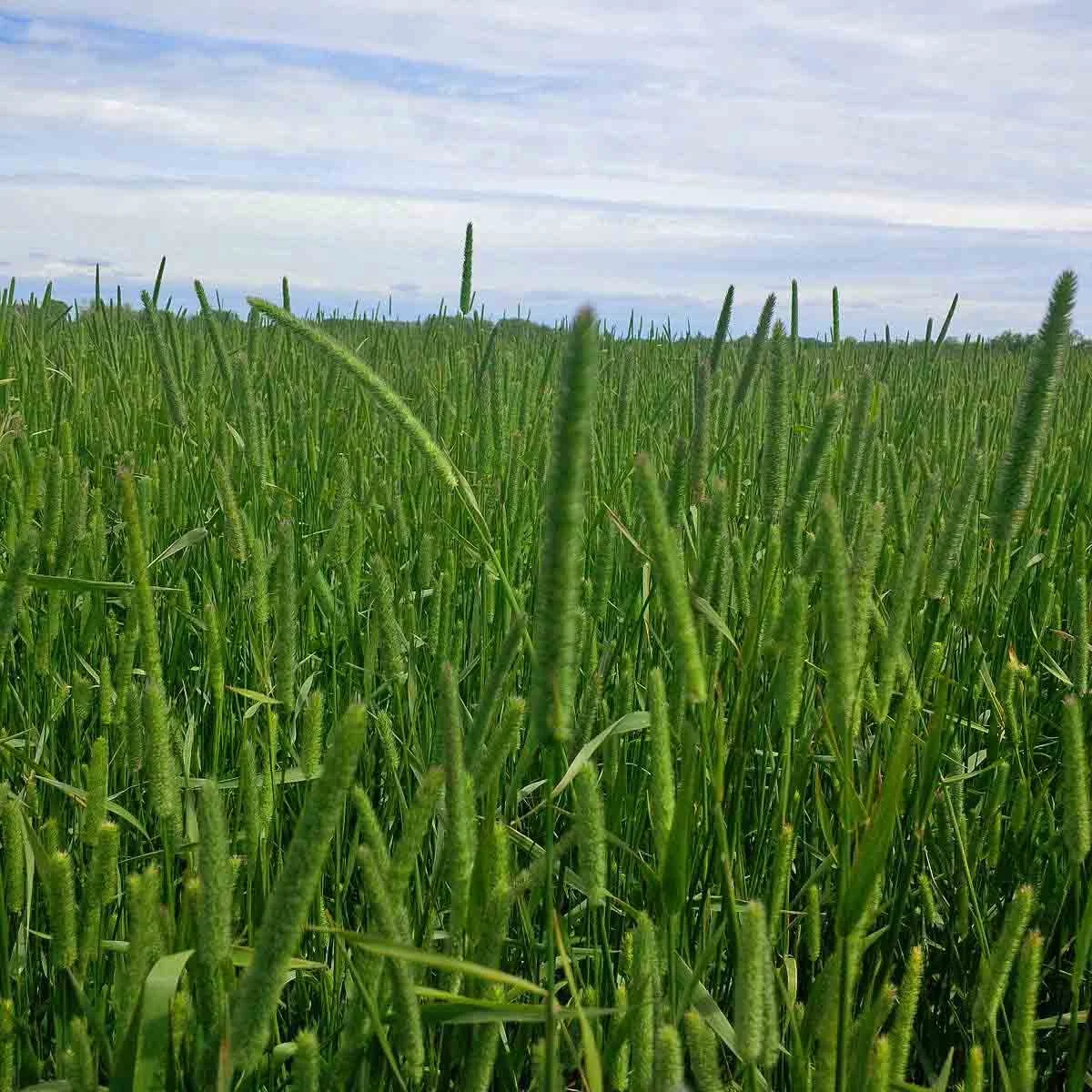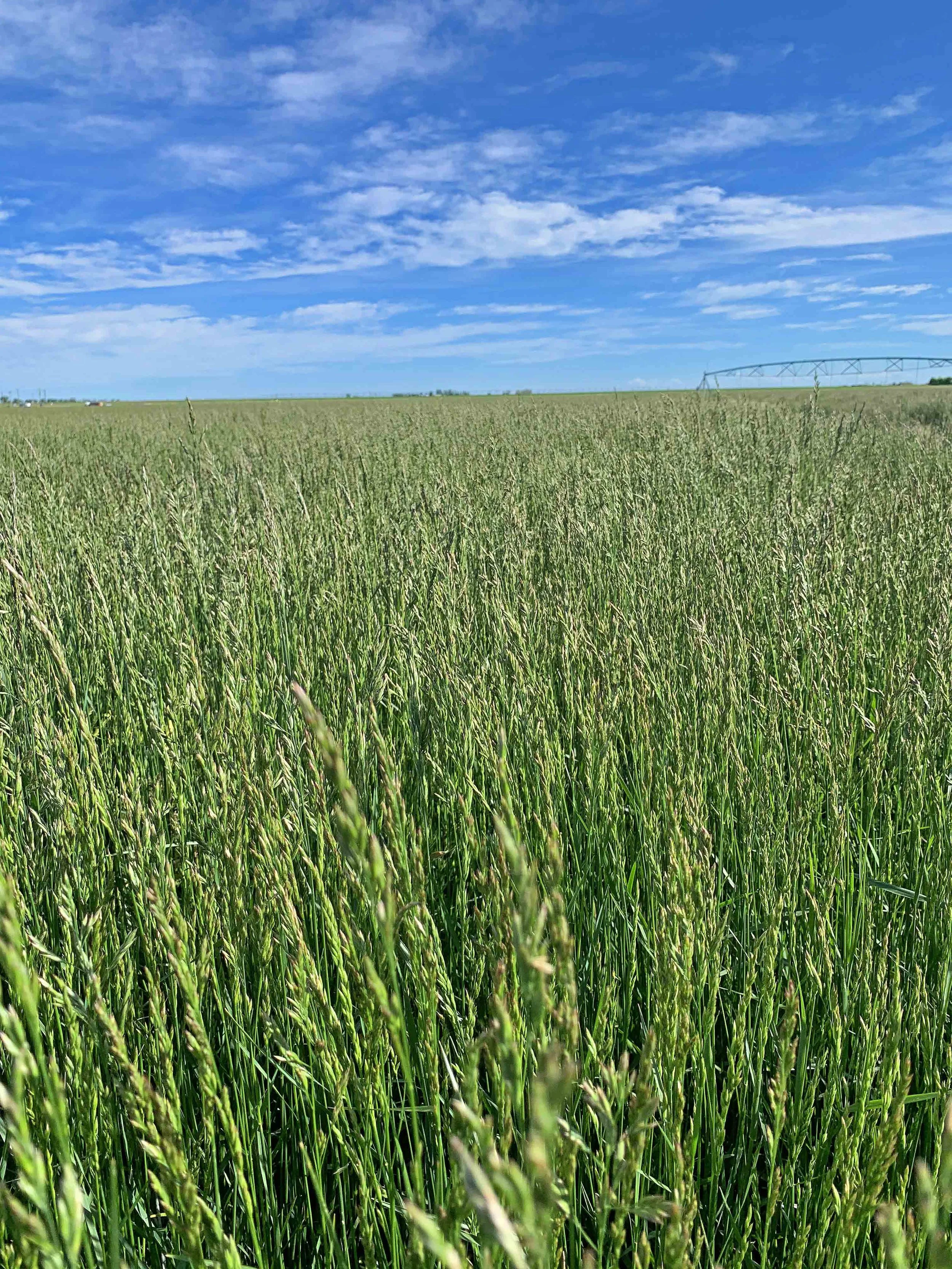WE PARTNER WITH PRODUCERS ON SEED PRODUCTION CONTRACTS.
Seed Production Guidelines
-
Contract Quality: The quality specs of the contract can influence field selection in terms of weed issues. Some weed issues to consider are Canada thistle, catchfly, cleavers, clovers, and volunteer canola
Seeding: Seed companion crop at half the normal rate and reduce nitrogen levels. Cereals and flax work well as companion crops. When selecting a cereal variety, choose one that stands well and is early maturing. Cover crop lodging is a concern in getting a proper establishment.
Seeding Depth: ½ inch (1 cm) or less.
Seeding Rate: 1 to 2 lb/acre (0.5 to 1 kg/acre), use a higher seeding rate when a companion crop is used.
Fertilizer: Alfalfa seed should be inoculated to ensure maximum nitrogen fixation. Other nutrient levels are best addressed in the year of seeding. Adequate Phosphorus levels will improve nitrogen fixation.
Pollination: Leafcutter bees are required to maximize seed yield potential for alfalfa seed. The general recommendation is 2 – 3 gallons per acre.
Weed Control: Consult our field staff for herbicide options.
Harvest: Harvest typically occurs late September and into October. Alfalfa seed is generally desiccated and straight cut combined.
-
Contract Quality: The quality specs of the contract influence the field selection, in terms of weed issues. Some weed issues to consider are quack grass, wild oats, other course grasses, Canada thistle, catchfly and cleavers.
Seeding: Seed companion crop at half the normal rate and reduce nitrogen levels. Cereals work well as companion crops. When selecting a cereal variety, choose one that stands well and is early maturing. Cover crop lodging is a concern in getting a strong establishment.
Seeding Depth: Up to ½ inch (1 cm)
Seeding Rate: 7 to 8 lb/acre (3 to 4 kg/acre)
Fertilizer: 110 to 150 lbs N/acre Ensure nitrogen is available to the plant when it breaks dormancy in spring to achieve maximum yield potential.
Plant Growth Regulator: Can be applied at 2nd node stage to reduce stem height. Provides easier swathing and often increases yield.
Weed Control: Consult our field staff for herbicide options.
Harvest: The field is ready to swath in the last week of July or first week of August, roughly 25 days after flowering. The seed is ready for combining 6 to 10 days after swathing. The seed is safe for storage at 10 to 12% moisture. Resources such as moisture charts and combine settings are available.
-
Contract Quality: The quality specs of the contract influence the field selection, in terms of weed issues. Some weed issues to consider are, catchfly, cleavers alsike, and Canada thistle.
Seeding: Seed companion crop at half the normal rate and reduce nitrogen levels. Cereals work well as companion crops. When selecting a cereal variety, choose one that stands well and is early maturing. Cover crop lodging is a concern in getting a strong establishment.
Seeding Depth: Up to ½ inch (1 cm)
Seeding Rate: 2 lb/acre (1 kg/acre)
Fertilizer: 80 to 100 lbs N/acre (40 to 50 kgs/acre) Ensure nitrogen is available to the plant when it breaks dormancy in spring to achieve maximum yield potential.
Weed Control: Grassy herbicides are best avoided. However, there are good broadleaf herbicides available for timothy seed production, consult our field staff for options.
Harvest: Swathing of Timothy seed begins mid-August. Swathing timing is important to ensure maturity while minimizing shatter losses. Combining can start from 5 to 14 days after swathing. Timothy seed is easily thrashed. Seed is safe to store at 12% moisture or less. Resources such as moisture charts and combine settings are available.
-
Contract Quality: The quality specs of the contract can influence field selection in terms of weed issues. Some weed issues to consider are quack grass, wild oats, Canada thistle, catchfly and cleavers.
Seeding: Meadow fescue establishes best without a companion crop. However if a companion crop is used we suggest seeding the companion crop at half the normal rate and reducing nitrogen levels. Cereals are the best option for companion crops. When selecting a cereal variety, choose one that stands well and is early maturing.
Seeding Depth: ½ inch (1 cm)
Seeding Rate: 4 to 5 lb/acre (1.75 to 2.25 kg/acre), higher seeding rate when a companion crop is used. Row spacing of 10 to 12 inches provides sufficient rooting room to enhance tillering and seed yield potential.
Fertilizer: 60 to 80 lbs N/acre (27 to 36 kgs/acre). Ensure Nitrogen is available to the plant when it breaks dormancy in spring.
Weed Control: Consult our field staff for herbicide options.
Harvest: The field is ready to swath mid August. The seed is ready for combining 6 to 10 days after swathing. The seed is safe for storage at 10 to 12% moisture. Resources such as moisture charts and combine settings are available.
-
Contract Quality: The quality specs of the contract influence the field selection, in terms of weed issues. Some weed issues to consider are quackgrass, wild oats, other course grasses, Canada thistle, catchfly and cleavers.
Seeding: Tall fescue establishes best without a companion crop. However if a companion crop is used we suggest seeding the companion crop at half the normal rate and reducing nitrogen levels. Cereals are the best option for companion crops. When selecting a cereal variety, choose one that stands well and is early maturing.
Seeding Depth: ½ to ¾ inch (1 to 2 cm)
Seeding Rate: 5 to 7 lb/acre (2.25 to 3.25 kg/acre), higher seeding rate when a companion crop is used.
Fertilizer: 90 to 110 lbs N/acre (40 to 50 kgs/acre) Ensure fertilizer is available to the plant when it breaks dormancy in spring.
Weed Control: Consult our field staff for herbicide options.
Harvest: The field is ready to swath in the last week of July or first week of August, roughly 25 days after flowering. The seed is ready for combining 6 to 10 days after swathing. The seed is safe for storage at 10 to 12% moisture. Resources such as moisture charts and combine settings are available.
-
Contract Quality: The quality specs of the contract can influence field selection in terms of weed issues. Some weed issues to consider are Canada thistle, catchfly, cleavers, volunteer canola and the presence of other clover species.
Seeding: Seed companion crop at half the normal rate and reduce nitrogen levels. Cereals and flax work well as companion crops. When selecting a cereal variety, choose one that stands well and is early maturing. Cover crop lodging is a concern in getting a proper establishment.
Seeding Depth: ½ inch (1 cm) or less.
Seeding Rate: 3 to 5 lb/acre (1.5 to 2.25 kg/acre), use a higher seeding rate when a companion crop is used.
Fertilizer: Red clover seed should be inoculated to ensure maximum nitrogen fixation. Other nutrient levels are best addressed in the year of seeding. Adequate Phosphorus levels will improve nitrogen fixation.
Pollination: Honey bees are required to maximize seed yield potential for red clover. The general recommendation is 2 strong colonies per acre.
Weed Control: Consult our field staff for herbicide options.
Harvest: Harvest typically occurs late September and into October. The crop can either be desiccated and straight combined or swathed when 75 – 80% of the seed heads are mature.
-
Contract Quality: The quality specs of the contract influence the field selection, in terms of weed issues. Some weed issues to consider are red clover, sweet clover, catchfly, cleavers, lamb’s quarters, red-root pigweed, and Canada thistle.
Seeding: Seed companion crop at half the normal rate and reduce nitrogen levels. Cereals and flax work well as companion crops. When selecting a cereal variety, choose one that stands well and is early maturing. Cover crop lodging is a concern in getting a strong establishment.
Seeding Depth: Up to ½ inch (1 cm)
Seeding Rate: 1-2 lb/acre (.5 – 1 kg/acre)
Fertilizer: Alsike clover seed should be inoculated to ensure maximum nitrogen fixation. Other nutrient levels are best addressed in the year of seeding. Adequate phosphorus levels will improve nitrogen fixation.
Pollination: Honey bees are required to maximize seed yield potential for alsike clover. The general recommendation is 2 strong colonies per acre.
Weed Control: Consult our field staff for herbicide options.
Harvest: Harvest typically occurs early September. The crop can either be desiccated and straight combined or swathed when 75 – 80% of the seed heads are mature.
-
Contract Quality: The quality specs of the contract influence the field selection, in terms of weed issues. Some weed issues to consider are red clover, sweet clover, catchfly, cleavers, lamb’s quarters, red-root pigweed, and Canada thistle.
Seeding: Seed companion crop at half the normal rate and reduce nitrogen levels. Cereals and flax work well as companion crops. When selecting a cereal variety, choose one that stands well and is early maturing. Cover crop lodging is a concern in getting a strong establishment.
Seeding Depth: Up to ½ inch (1 cm)
Seeding Rate: 1.5-2.2 lb/acre (.75 – 1 kg/acre)
Fertilizer: Birds-foot trefoil seed should be inoculated to ensure maximum nitrogen fixation. Other nutrient levels are best addressed in the year of seeding. Adequate phosphorus levels will improve nitrogen fixation.
Pollination: Honey bees are required to maximize seed yield potential for birds-foot trefoil. The general recommendation is 2 strong colonies per acre.
Weed Control: Consult our field staff for herbicide options.
Harvest: Harvest typically occurs early mid-August. The crop can either be desiccated and straight combined or swathed when 75 – 80% of the seed heads are mature. The crop must be closely watched during harvest time due to the indeterminate growth habit.








